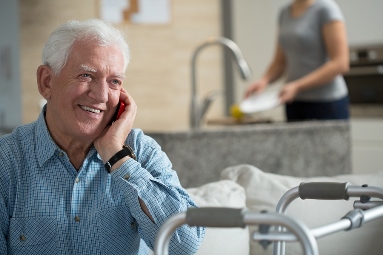By: Brad Breeding
A huge majority of seniors today prefer to stay in their home for as long as possible. In fact, according to research by the AARP, almost 90 percent of seniors want to “age in place.” While this might sound like a good ideain theory, there are potential challenges associated with this senior living situation. As we discussed in a recent blog post, the family members who are charged with senior home care often face mounting mental, physical, and financial stress.
But thanks to the many technological advancements we have seen in the last decade, aging in place is becoming simpler and safer for seniors, and less stressful for their loved ones. The best tech option(s) for seniors who want to stay at home will depend on your loved one’s existing medical conditions, their financial resources, and personal preferences, but here is an overview of some of the newest gizmos and gadgets that can improve the safety and wellbeing of seniors who hope to stay in their own homes.
Personal emergency response systems
Everyone remembers the classic “I’ve fallen, and I can’t get up!” commercials. Well, emergency medical alert systems are still around but have been updated and improved for the modern era. Also referred to as personal emergency response systems, or PERS, these are essentially wearable “SOS” devices, often in the form of a pendent or bracelet with a base station that connects to a phone line. Press the button and the system acts as a powerful speaker phone, allowing the senior to call for help.
There are numerous types of monitored and unmonitored PERS, and the cost varies accordingly. A few examples:
LogicMark’s Freedom Alert is an emergency button that can be worn as a pendant or clipped to a belt. The device includes a two-way speaker that the senior can talk into to contact friends, family, or a 911 operator, depending on which setting is selected. The system costs $300, but there are no monthly monitoring fees. For another $120, there is an optional “emergency wall communicator,” which is a water-resistant device that can be mounted next to a toilet, bathtub, or bed. The trade-off: the Freedom Alert system lacks the fall-detection capability of some of the other monitored systems.
At a cost of around $35 per month, Philips Lifeline is the most popular monitored medical alert service in the country. While similar in concept to Freedom Alert, this system also has an Auto Alert option that uses sensors inside the SOS button to detect a fall, automatically calling for help without the senior even having to press the button; this upgraded feature costs an additional $13 per month.
GreatCall Responder offers wireless PERS devices that work in conjunction with the company’s Urgent Response monitoring service. Seniors can press the button on the GPS-enabled Responder device to be connected immediately to either 911 or to the company’s trained response agents who will determine the user’s location, assess the situation, and can then conference in family or friends, call 911, or contact a nurse, if needed.
The above article was written at myLifeSite and is legally licensed for use.


Recent Comments